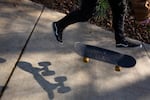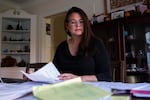When the state of Oregon takes a child from their home, child welfare officials assume responsibility for their health and happiness, and for ensuring each youngster receives the care and treatment needed to succeed.
But emails, case files and interviews show that for children in foster care who were sent across state lines, Oregon largely trusted a private, for-profit company to ensure they were safe.
The result is a litany of disturbing outcomes: tales of abuse, neglect and vulnerable children left to fend for themselves.

Caleb climbs a tree near his adult foster home on Monday, Nov. 11, 2019, in Oregon. He says this spot on the Willamette River is meditative and important to him because he can't see any man-made buildings or structures from there.
Bradley W. Parks / OPB
For a moment earlier this year, Caleb seemed to be doing well at Red Rock Canyon School.
The 17-year-old boy was living in a former hotel that had been converted into a locked youth treatment center in St. George, Utah. He was hundreds of miles from home, and so the state of Oregon largely relied on social workers in Utah to check on him and report back.
A Feb. 8, 2019, note from the social worker assigned to look in on Caleb was reassuring: He seemed content and happy. He got along with his peers. He sounded more optimistic than he had in a previous visit.
There was just one problem: The note was about the wrong kid. And Caleb wasn’t doing well.
A month later, Caleb’s caseworker in Oregon spoke to the teenager on the telephone. She noted Caleb said he still hadn’t met the man who was supposed to be making face-to-face contact with him.
“Caleb … expressed feeling very hopeless,” she wrote. “He wants to go home and be a normal kid, not a kid in the system … He feels unheard …”
Between 2016 and 2018, the number of foster children Oregon leaders sent to residential treatment facilities out-of-state increased by 168%. Children, some as young as 9, were scattered across 16 different states. The majority of them were placed in facilities owned or operated by one company.
Oregon Foster Children Placed In Out-Of-State Facilities
This map shows the number of times children in foster care were placed in residential treatment facilities out-of-state. Some children went to more than one out-of-state facility.

This map shows the number of times children in foster care were placed in residential treatment facilities out-of-state. Some children went to more than one out-of-state facility.
Source: Oregon Department of Human Services / OPB
Source: Oregon Department of Human Services
When pushed to explain the jump, Oregon child welfare officials pointed to dwindling options in Oregon where they could house children in foster care. They also said kids were being sent to facilities with unique programs to meet the specific needs of each child.
But a review of case files, thousands of emails and interviews with foster youth unearthed a more complicated reason for why Oregon’s use of out-of-state facilities jumped so quickly: A private, for-profit business called Sequel won the right to house the state’s most vulnerable children in large part because its marketing executives built a relationship with beleaguered and increasingly desperate child welfare workers.
The farther away Oregon kids went, the harder it became for anyone back home — especially the state officials serving as their legal guardians — to hear their voices or track their basic safety and well-being.
And once Sequel earned Oregon’s business, emails show, the state placed a lot of trust in the for-profit company making money off the state to ensure children such as Caleb were safe and receiving the care they needed.
The result is a litany of disturbing outcomes.
At Sequel’s flagship facility in Iowa, a 16-year-old Oregon boy went to the emergency room after other children attacked him. They later defecated on his clothes. The boy was also allowed to use a staff member’s tablet and while doing so, the teenager saw a video of the staff member’s girlfriend performing oral sex. The same staffer gave the boy Marlboro Black cigarettes to smoke on a walk, according to case notes.
At another Sequel campus, three adults held a teenage girl from Oregon on the ground by her feet, arms and stomach while she struggled to breathe. That was on the first day she arrived and after she had refused to hand over a photograph of her deceased brother. When police investigated the incident, the officer asked what the protocol was for restraining children. The staffer told the police officer children were restrained until they were cooperative and staff had control. The teen spent more than a year in that facility and was told by staff she was there because “no one cared about her.”
At the same facility, in St. George, Utah, the same campus where Caleb was placed, a dispute between students and staff turned into a full-fledged riot that led the local SWAT team to respond. They came armed with AR-15s and Glock handguns.
>>Read: Key findings of OPB’s investigation into Oregon’s broken foster care system.
Oregon isn’t the only state that turned to Sequel to help solve a growing foster care crisis despite allegations of widespread use of restraint and violence.
An August 2018 report from the state of California notes that at Sequel’s flagship facility, Clarinda Academy, several children were made to sit in chairs facing the walls all day during the weekends and from 3 p.m. until 9 p.m. during the work week. They weren’t allowed to interact with anyone during this punishment, which lasted three weeks. At the same facility, the threat of being physically restrained was always looming: One Washington foster youth told investigators he was afraid to refuse any of the food for fear of being physically restrained. Another child was reportedly restrained for more than 45 minutes and another passed out after being held down by staff.
To send Caleb to Utah, Oregon needed a judge’s approval. Child welfare officials called an emergency court hearing on Dec. 19, 2018.
When Caleb first heard their plan to put him on a plane and send him to another state, his breathing grew heavier and he remembers struggling to catch his breath.
He thought about flipping over a table or causing some kind of scene in the courtroom so he would be charged with a crime. At least that way, he said later, he would be thrown in a juvenile detention center and kept in Oregon.
Change didn’t bother Caleb; by the time state officials asked a judge to send him to Utah, a few days before Christmas 2018, he had already lived in more than 30 places and attended 10 different schools. But as long as he was in Oregon, he knew who to call if he was in trouble.
“Oregon is my safe space,” he said. “It’s my network. You could drop me off anywhere in Oregon, and I could figure out how to get back.”

Caleb skates through a public park Monday, Nov. 11, 2019, in Oregon. He likes living in a small town, he said, because he gets around mostly on foot and by skateboard.
Bradley W. Parks / OPB
In Utah, he would be far from his brother and hundreds of miles from his girlfriend. He had no way of knowing what else he would face.
Somewhere along the way, the state of Oregon stopped listening to the foster youth they are charged with protecting.
But they kept listening to Sequel.
THE MORE POWERFUL VOICE IN THE ROOM
Sequel Youth and Family Services was founded in 1999 to run a school for delinquent boys, according to its website.
The Alabama-based company now operates more than 40 programs in 20 states and in 2016 brought in $200 million in annual revenue. In 2017, Altamont Capital Partners, a private investment firm based in San Francisco, acquired a majority stake in Sequel.
Sequel executives have been up front with their private-equity investors about plans for growth: In a 2017 pitch, Sequel noted the company had “favorable supply/demand dynamics” in its corner due to a “significant reduction in inpatient beds at state and local levels.”
Oregon, like other states, has struggled to find appropriate places to house its most vulnerable children. In 2016, lawmakers and the public were outraged to discover some Oregon children in foster care were sleeping in hotels or state offices due to a lack of other options. In 2018, after pressure from a lawsuit, the state agreed to incrementally reduce the number of children they placed in hotel rooms.
Around the same time, Oregon child welfare officials began increasing the number of children sent to private, out-of-state facilities.

The Oregon Department of Human Services building is pictured in Salem, Ore., on Sept. 26, 2019. Beleaguered and increasingly desperate child welfare workers trusted the private, for-profit Sequel Youth and Family Services with the state's most vulnerable children, despite allegations of abuse.
Bradley W. Parks / OPB
In January 2019, child welfare officials appeared to register some concerns about the increase in the number of foster kids being shipped across state lines.
State officials knew they lacked the manpower to keep track of Oregon children once they left the state. The two women at the top of Oregon’s child welfare infrastructure emailed each other to discuss potentially adding staff.
“We need to get a handle on this, but until then?” Jana McLellan, the deputy child welfare director at the time, wrote to her boss, Marilyn Jones. “Or do we just stop?”
“I seem to remember you saying no more but we keep going. :)” Jones wrote back, adding a smiley face emoji.
For most of the time the children were out of state, Oregon had neither a centralized way to track reports of abuse nor a robust way to track the location of all the children.
When Oregon wanted to hire a social worker to visit the children who were out of state in person, they asked Sequel for suggestions for whom to hire. And when a state lawmaker started to raise concerns about the children placed across state lines, child welfare officials once again relied on Sequel for answers.
In February 2019, officials in Tennessee emailed their Oregon child welfare counterparts an alert: Tennessee was suspending the license of a Sequel facility there.
“... all youth must be removed from the facility,” read the email from Tennessee’s Department of Children’s Services.
Within hours of receiving that email, Glenda Marshall, a key Oregon child welfare official, forwarded it to a marketing executive with Sequel.
Marshall wasn’t writing to question Sequel’s treatment of the kids. Instead, she wanted to know whether the February deadline for removing an Oregon child was actually “a set date.”
Marshall had no cause for concern. Sequel officials assured Oregon staff that the building was simply outdated and needed some repairs.
Yet sheriff’s deputies had been called to the Tennessee facility more than 100 times in 2018, according to local news reports. In January and February 2019, Knoxville TV station WBIR reported that police responded to the Tennessee campus 36 times for complaints ranging from assault to vandalism to runaways.
In April 2019, Oregon state Sen. Sara Gelser, a Corvallis Democrat who was a catalyst in bringing foster children back, emailed top child welfare officials raising concerns about Sequel’s Mountain Home Academy, an Idaho facility where 17 Oregon kids were placed.
The subject line: CONFIDENTIAL correspondence.
“We currently have 17 children in this facility in Idaho … but state and local authorities in Idaho refuse to place Idaho kids there due to safety concerns,” Gelser wrote.
Within about two hours, Marshall forwarded Gelser’s email to another Sequel marketing executive focused on Oregon.
“Here you go …” Marshall wrote.
That was the end of the exchange. State officials never responded to Gelser.
In June 2019, Marshall had another question for a Sequel marketing executive about a child in the company’s care: “Do you know anything about a youth at Forest Ridge drinking bleach and ending up in the hospital?” she asked in an email.
FOSTER KIDS INC.
By 2019, Oregon Child Welfare officials had exchanged thousands of emails with Sequel marketing staff. And the tone of the exchanges became increasingly familiar; the visits and emails had turned a business relationship into a friendly one.
Jarrett Shoemaker, a regional marketing executive for Sequel, first reached out to Oregon in 2015. He traveled to Salem to present to Oregon child welfare staff.
“You have a great team and I appreciate how kind you have been,” he said in one of his first emails to Laurie Price, a state manager.
At the time of the email, Oregon had only placed five children in foster care out of state. Shoemaker’s job was to boost that number.
“Assuming I don’t fly out, I’m staying in Salem tonight if you or any of your staff care to meet for dinner,” he wrote.
He also looked for ways to put Sequel staff in front of state officials.
“Are there any conferences coming up this summer I should be aware of?” Shoemaker wrote a handful of child welfare staff in May 2016. “We like to participate in a variety of different conferences and golf tournaments if possible.”
It seemed like a win-win. The state would have a place to put children. Sequel would secure state contracts worth millions of Oregon taxpayer dollars.
By March 2018, Oregon had 56 foster youth placed out of state — including 44 at Sequel campuses.
That same year, the Oregon child welfare manager who oversaw the out-of-state program at the time felt comfortable enough to jokingly suggest Shoemaker relocate:
“Isn’t it time for Jarret[t] to move to Portland permanently?” Peter Rosenblatt wrote, directing his staff to “... please write a contract for Jarret[t] to relocate to Oregon.”
In November 2018, Glenda Marshall, with Oregon child welfare, mailed cookies to a Sequel admissions coordinator in Utah.
“Thank you so much Glenda! You are so sweet! And so are the cookies you sent! We love working with you!” the Sequel staffer wrote in response.
All told, through November 2019, Oregon placed 127 children in Sequel facilities.
For Oregon officials, Sequel helped solve — at least temporarily — a political problem, the image of children sleeping in hotel rooms and on office floors.
For Sequel, Oregon was a huge potential profit source.
The state calculated it spent on average $10,718 per month, per child on out-of-state facilities. At the height, the state had 88 foster youth placed out of state at once, including 78 in Sequel facilities. The state estimated it spent about $13 million in 2018 and 2019 when children were out of state.
Gelser, the state senator, thinks the total amount Oregon spent is likely even higher.
“Oregon is not only paying out-of-state providers more money than it pays in-state providers, it purchases fewer services with that money and holds the providers to lower standards than in-state providers,” Gelser said.
Taxpayers did pay a higher price for Sequel beds than options closer to home. When children are placed in state, Oregon can use federal Medicaid money to cover some of the costs. But Oregon didn’t tap federal money to cover out of state facilities.

Caleb as a child. He was only 4 years old the day state workers came to his mom's apartment.
Provided photo/Illustrated by OPB
THE FORGOTTEN
Caleb was only 4 the day state workers came to his mom’s apartment.
He remembers sitting on the couch without any clothes, wrapped in a blanket, watching the Disney movie “Cars.”
His mother’s boyfriend had recently thrown a chair, shattering a 150-gallon fish tank; in his memory, broken glass, dead fish and pill bottles littered the apartment floor.
A week earlier, one of his brothers had gone to school with bruises, kicking off an investigation that led to state intervention.
Caleb thinks his mom was crying as she helped him dress and put him in the caseworker’s car, but he’s not positive.
“I remember asking them, ‘Am I ever going to come back here?” he said in a recent interview.
After he was removed from his mother’s care, Caleb bounced around to different residential treatment centers and foster homes for three years.
On May 26, 2010, someone dropped him off at the Olalla Counseling Center in Toledo, Oregon.
He had been to the center before. This time was different.

The Olalla Counseling Center in Toldeo, Ore., Thursday, Dec. 5, 2019. Caleb remembers when he came here in 2010 as the first time he opened up to someone about his childhood trauma.
Bradley W. Parks / OPB
“Couldn’t calm himself down,” a caseworker noted at the time. “Once calm, I explained to him that he was feeling pain. He asked why [his mother’s boyfriend] did all those things to them if he loved them and why his mom let him beat her.”
It was the first time Caleb, 8 at the time, remembers opening up to someone. He spoke to Ben Williams, a counselor at the center, for four hours. The two talked about pain and what it does to a person.
“You have to learn about it and recognize it, because it will always be a part of you,” Williams told the boy, according to his notes of their conversations.
“It comes from [my mother’s boyfriend],” Caleb said.
Williams suggested Caleb write a list of everything the man dating his mother did to him. Like the time he put tape over Caleb’s mouth so no one could hear him scream as he was beaten. Or how he would praise Caleb when he did something bad and beat him when he behaved well, messing with him psychologically.
Caleb considers Williams, who still works at Olalla Center, one of the most important people in his life. Even though Caleb was only 8, it was clear to the social worker then what kind of environment the boy needed to succeed.
“Caleb really reacts well to calm reassurance,” Williams wrote in 2010, adding later in the same document, “Empathy is the best tool … The people he reacts to best are the ones who are the calmest and most naturally empathetic.”
Caleb did have one long-term foster care home, from when he was 7 years old to when he was 15. He still considers the woman who cared for him during that time period to be his real mom. She taught Caleb discipline, he said, and showed him what parental love looked like. She taught him proper hygiene and how to drive. But in his teenage years, Caleb started to rebel. He began smoking cannabis. He spent a lot of time with a girlfriend. And his foster mom’s partner died. After eight years, the placement no longer worked.
Before Caleb landed in Utah, he lived on the run in Oregon.
He hitched rides up and down the Interstate 5 corridor, from Portland to Corvallis to Eugene to Yoncalla. On the run, he felt free. He had control over his life. No one told him what to do, to tuck in his shirt or talk about his feelings.
Even when he was on the road, Caleb would show up for his court appointments. He would call Williams, his lawyer and his former foster mom to check in and let them know he was safe.

Ben Williams outside Olalla Center in Toldeo, Ore., on Thursday, Nov. 9, 2019. Williams has known Caleb for most of the teen's life.
Bradley W. Parks / OPB
Caleb has struggled over the years with anxiety and depression and been told he has post traumatic stress disorder. In an ideal situation, he would have landed in another loving home, a place where he might feel secure and cared for and have time to let his mind stop racing.
“I was not a fan of sending him out of state,” Williams wrote in an email recently. “Other state laws, especially Idaho and Utah, can be pretty loose in residential treatment. … It is really sad, because we should be able to get a kid into one of these programs where their nervous system can calm, they can be fed and nurtured … and then connect them to some consistent housing.
“The system is so broken, just typing that makes me laugh at how unlikely getting all of those to happen is.”
DIRTY LITTLE SECRET
In 2018, an attorney with the advocacy group Disability Rights Washington decided to investigate Sequel’s flagship campus: Clarinda Academy in Iowa.
Lawyer Susan Kas said her group decided to investigate Clarinda, a handful of brick buildings on the same campus as a prison, simply because it housed the most children from Washington state, about a dozen at the time. In other words, the advocacy group chose Clarinda essentially at random, not because they suspected anything was wrong.
Disability Rights Washington is federally mandated to protect and advocate for individuals with disabilities. Federal law gives its team the ability to access more records than the public can.
They used that power to study Clarinda. Their conclusion: Foster children were being abused, repeatedly, in a prison-like setting.
Investigators with the nonprofit wrote that Washington’s use of out-of-state facilities to house foster children was “creating an unacceptably heightened risk of abuse and neglect” and causing more “harm to youth who have already suffered from multiple, prolonged, or chronic traumatic events.”
Washington had more than 70 child-specific contracts for out-of-state care; 75% of those were with Sequel.
The investigation found the environment at Clarinda was “very restrictive” and “policies, training, and oversight do not adequately protect against the risk of abusive restraints.”
Kas told OPB then that the group’s findings warranted a much deeper look at the national trend — what she called the “dirty little secret” — of sending children in public care to for-profit private facilities far from home.
Children described being restrained and having staff “put their hands on you and force you to the ground.”
“They separately and independently demonstrated how staff pull their elbows behind their backs and then force them to the ground by putting pressure on the backs of their knees,” the investigators wrote.
A psychologist involved in Kas’ investigation noted that using physical force to restrain children can actually worsen their behavior, particularly for kids who have already been traumatized.
When Washington state leaders learned of the reports of abuse at Clarinda, they moved swiftly to remove Washington children. Oregon, in contrast, went into overdrive to control the narrative.
Internal correspondence show that state officials dragged their feet on releasing information to the public and tried to conceal the names of the private facilities where children were placed from reporters.
In a February, 2019 email with the subject line, “Oregon media heads up,” Glenda Marshall, with Oregon child welfare, wrote to the executive vice president of Sequel to warn him about the inquiries from journalists.
“We just wanted to inform you that this afternoon, despite our request to keep this information confidential, the media here in Oregon was given a list of programs where Oregon youth are placed for treatment in other states,” Marshall wrote. “If any of your programs get requests from the media about these youth, we ask that you not share any information, including the number of youth or even confirming that you have Oregon youth there, out of concern for the privacy of our youth and families. Thank you so much for being a great partner.”
The same month, after the first public reports of abuse, Marilyn Jones, then the state’s child welfare director, said Oregon had to rely on private, out-of-state homes because state workers simply couldn’t find appropriate treatment beds in the state.
“Most of these are older kids that really have very unique needs that not many people can meet,” Jones told OPB at the time. “And so when you’re able to look across 50 states for something like that, you’re going to find a better array of services for kids that really are unique to that child.”
As more troubling stories emerged, Oregon child welfare officials emphasized in their public comments that the children being sent out of state represented the most complicated cases. They were only going elsewhere because they needed specialized therapy Oregon could not provide.
Yet in 2018 Oregon child welfare officials had discussed purchasing beds 25 at a time at out-of-state Sequel facilities. They also wanted to work out a deal with the company to expedite the process for Oregon kids so they could be placed in the beds quicker, emails show.
The plan was to pay for the beds and then figure out which kids to fill them with.
‘I’M YOUR DADDY NOW’
Caleb’s introduction to life at Red Rock was rough.
There were palm trees outside the residential treatment center, but Caleb said he also noticed the large fence surrounding the place. It was topped with spikes, which faced inward, he said.
During the intake process, Caleb said, he watched a kid being “thrown around in the hallway and restrained.”
“This is the first five minutes,” he said, “and I was like, ‘Whoa.’”
The staff member told Caleb to take off his clothes and his jewelry. He handed over his shoes. The Red Rock employee gave him a rag for the shower and explained the rules: six minutes total, four under the water and two to dry off.
Caleb told the staffer, a man he described as “jacked” and muscular, that he didn’t want to hand over the gauges he had in his ears. He remembered the man leaning close and telling him, “I’m your daddy now. You’re going to do what I say.”
The man took Caleb’s jewelry. He gave Caleb paper slides to put on his feet to replace his shoes.

Caleb, left, shops for new gauges Thursday, Sept. 26, 2019, in Oregon. Caleb said a muscular male staffer told him to remove his jewelry when he arrived at Red Rock Canyon School, a foster care facility in Utah. Caleb didn't want to hand over his gauges.
Bradley W. Parks / OPB
That first night, the then 16-year-old curled up on his bed in the room he shared with three other boys and cried.
“Let it out,” another staff member told him.
It was four days before Christmas 2018. Even though Caleb had bounced around for much of his life, he had always managed to be in a family setting for Christmas. This time, he couldn’t even call the person he considered his mom, the woman who had fostered him for years.
After Caleb sobbed for a few minutes, he said, the same staffer yelled at him.
“Shut the fuck up, man,” Caleb remembers the man saying. “No one wants to hear that.”
The first few months at Red Rock, Caleb wrote regularly in his journal. He’d been dating the little sister of his best friend off and on for about a year when he was sent to Utah. It had taken him a long time to work up the nerve to ask her out. She came up often in his journal entries:
“I miss Oregon, but more than anything, I miss my girl, Hannah. I love her so much. She is the light at the end of my tunnel.”
Caleb spent a lot of time in Red Rock worrying about the future. This was supposed to be the time he spent figuring out what life was going to look like when he was no longer in state custody. He was both terrified of turning 18 and exhilarated at the thought of being free from the state’s child welfare system. He figured he would get a job and start to save money toward a future welding career.
“I always thought life would be different. That I would get a home before I was 17. But that's not the case. Life isn't all the way it should be.”
Most days at Red Rock followed a similar pattern. Mornings were often spent in the basement classroom sitting at a computer. He made sure his shirt was tucked in for “transport,” traveling from the classroom to the cafeteria. And he tried to avoid eye contact with girls to prevent getting in trouble. There were usually some physical activities in the afternoon on campus, then free time, shower and bed. Twice a week he had therapy, one individual session in which he could listen to music and a family session when he could make calls to people back in Oregon.
Writing helped him cope and fill the days.
“So much pain from trauma. From being abused as a child ... From being forgotten. From not mattering to anyone. Being disregarded. Told I'm worthless ... I wish I knew the joys of loving parents. I wish I knew my mom as a mother. Not as someone who finds pills and men more important than getting her own kids back. I wish I met my dad. I wish I was able to bond with him.”
Oregon sent children in foster care — children removed from their homes because of their parents’ struggles or their own significant psychological needs — to the Red Rock facility, Caleb said. Other states sent youth with violent backgrounds.
“Most of the kids here are fighters and violent. I’m not a violent person,” Caleb told a caseworker in May.
One former Red Rock employee said the safety of nonviolent kids was compromised. “It’s like taking everyday kids and dropping them off in juvenile jails,” the staffer said.
“There was nothing good about Red Rock,” Caleb said in an interview this fall. “The only thing that was maybe good — and it’s not even that good — is all of us kids in there have a trauma bond. Even the … kids that thought they were super cool and thought they were the bad of the bad got traumatized there.”
On April 25, 2019, a staff member at Red Rock assaulted Caleb. He stopped writing after that. He couldn’t seem to focus, he said.
The assault happened shortly past 11 p.m. Caleb had planned to meet some girls in the facility’s courtyard. He didn’t make it far when someone alerted him the girls weren’t coming. This was after hours, and he was supposed to be in bed, but he detoured to a friend’s room.
After a few minutes, a Sequel staff member entered and spotted Caleb. The staffer grabbed Caleb’s right elbow. They scuffled.
Later, a police officer watching a video of the incident noted that, despite another adult entering the room and separating the man and Caleb, the Sequel employee kept getting in Caleb’s face.
Caleb told the police the man lunged for his throat and screamed that he was going to “fucking kill” Caleb. The staffer told police he didn’t say he would “fucking kill” Caleb. He might, he told officers, have said “I will fuck you up.” He also claimed Caleb hit him, but both video evidence and other staff testimony contradicted that.
Police cited the staffer for child abuse simple assault.
A few days later, on April 28, 2019, a brawl erupted on the Red Rock campus.
Members of the St. George police force responded to a call of disorderly conduct in progress. A fight had broken out, and staff couldn’t control the situation. Residents were using whatever they could find — a toilet seat, broken glass, rocks — as weapons against each other and staff.
The school’s courtyard was a scene of disorder and confusion when the local SWAT team arrived.
“As I entered the courtyard I could see blood drops all over the walking path,” one police officer wrote. “The blood seemed to be on all of the paths and it appeared to be new.”
Later, police would report they heard from residents and staff that the violence started after a Sequel employee called a group of female residents “thirsty hoes,” “bitches” and “sluts.” The male staff member was also reportedly hitting female residents and pulled one around by her hair, according to police reports based on testimony by children at Red Rock.
A few days later, on May 1, 2019, police responded to yet another call that Caleb had been assaulted.
A staff member identified as “JR” in the police report and known as “Junior” among residents reportedly reprimanded a student for not tucking in his shirt. He told the student he wouldn’t be able to go to therapy that week unless he complied.
Caleb told the staff member someone shouldn’t lose therapy for not tucking in their shirt.
From there, according to a police report, surveillance camera video shows Junior knocking something out of Caleb’s hand and slamming Caleb up against a box. The man turned Caleb to pin his chest up against the box with his arms behind his back, then held Caleb there.
The police report notes the Sequel staffer later said he had “been on edge this week due to the riot,” the officer wrote. Employees had been directed to “ensure none of the kids got out of line and to be very diligent in not letting any small issues escalate into big issues.”
Caleb had bruises on his back, a 4-inch abrasion and a sore jaw, according to casenotes.
Junior told the police officer he didn’t mean to hurt Caleb.
“Jr explained to [the police officer] he has not been trained at Red Rock Canyon School on how to properly do the upper torso restraint, but he had seen other staff do it,” according to the police report.
After the assault, an Oregon caseworker called to touch base with Caleb. The caseworker, taking notes, asked Caleb if he needed anything.
“Dignity,” the teenager said.
A TALE OF TWO STATE REPORTS
Two days after the brawl at Red Rock, Oregon sent child welfare employees to visit the campus.
The timing was pure coincidence, a result of political pressure back home. After it was discovered Oregon was sending foster youth out of state, legislative scrutiny prompted state child welfare workers to start visiting the facilities.
Oregon child welfare’s report on Red Rock struck a strikingly upbeat tone. State officials wrote that it was slightly difficult to “weed through” the interviews with the foster youth, since they were still “very escalated” from the riot.
But after speaking to 23 of the 25 Oregon children in Utah, the consensus was “there was no significant pattern of safety and/or programmatic concerns that would dictate removing children from the program.”
Oregon officials noted in their report that Caleb might soon need to leave Red Rock — not because of concerns for his safety, but because Sequel wanted him out.
“He is completely checked out of the program at this point and as a result I expect, given what Red Rock management said today that they will be asking for him to be removed,” the Oregon staffer reported.
The Oregon official also watched video evidence of the assault on Caleb.
“... while it didn’t strike me as a choking incident as previously reported, there was no doubt that the staff member was going after [Caleb] and made inappropriate physical contact with him at multiple points,” they wrote.
Overall, the Oregon child welfare staff wrote in the internal memo they came away feeling “pleased with the helpfulness and response of the program.”
On May 10, child welfare staff released a public letter to legislative leaders painting a rather rosy review of the facility. At Red Rock, they wrote, the bedrooms were clean, and there was room by the beds for residents to personalize their space. They noted that young people housed there could practice yoga and meditate. The children, the report stated, had plenty of opportunities to express themselves.
Oregon officials didn’t know that the state of Utah also took a close look at Red Rock after the riot. Utah investigators issued their report one day before Oregon’s came out. It was far less flattering.
The state of Utah’s office of licensing listed a litany of abuses, from staff humiliating and degrading youth to concerns about severe understaffing that led to violence, misconduct and both staff and residents feeling unsafe.
“Some staff report working 16 hours a day, 7 days a week, leading to staffing ratios that, at times are already insufficient, being filled with staff who are physically, emotionally and mentally exhausted,” regulators wrote.
Red Rock Canyon School officials told Oregon Child Welfare they would reduce the number of children at the school from 97 to 60 and would no longer be accepting new children.
All told, 38 Oregon children were placed at Red Rock.
THE LEAST POWERFUL VOICE IN THE ROOM
Staff at Red Rock told Caleb he wasn’t allowed to talk about the riot. He was specifically told not to speak about it with his caseworker or attorney, Caleb said later.
His former foster mom found out about the violence via local newspaper stories and told his attorney. The lawyer, Alan Reynoldson, was livid. He called for a juvenile review hearing in the court overseeing Caleb’s case.
In court, Reynoldson asked why he wasn’t told about the assaults or the riot. The local caseworkers told Reynoldson they were directed by “Salem” — meaning top child welfare officials — not to alert anyone to the assaults or brawl, according to the lawyer.
Caleb wanted out of Utah. And he knew this was likely his best shot.
He prepared for the May 3, 2019, hearing, jotting down a list of staff deficiencies that he could share in court.

The Lincoln County Courthouse on Thursday, Dec. 5, 2019, in Newport, Ore. Caleb called his testimony into the courtroom from Red Rock Canyon School to say that he had been assaulted and wanted out of Utah.
Bradley W. Parks / OPB
He testified over the phone. On the loudspeaker, his voice sounded steady and calm as he told the room of lawyers, his caseworker and a judge that he had been assaulted twice by staff members who had not been properly trained. He threatened to take his story to the local newspaper.
Back in the courtroom, Reynoldson recalled later, he asked Caleb’s caseworker, “Do you think Caleb is safe?”
She hesitated before answering:
No.
The state of Oregon moved swiftly — not to remove Caleb, but to seal the audio and the transcripts of the hearing. That would ensure the public wouldn’t be able to read or hear how bad things had become for this child in the state’s care.
State officials said they sealed the documents to protect Caleb.
“As the legal guardian of children in foster care, DHS has a legal obligation to consider the long-term consequences of publicly disclosing the most intimate details of a child’s medical needs, family situation and trauma history,” Jake Sunderland, the spokesman for Oregon’s Department of Human Services, which oversees the Child Welfare Division, wrote in an email.
Reynoldson, Caleb’s lawyer, disagrees with that assessment: “This was used to protect the state, not the kid,” he said.
For most of his life, Caleb has been in the state’s care. In some ways, the state raised Caleb.
“The state,” Reynoldson said, “is a pretty shitty parent.”
‘THESE KIDS ARE CLEARLY IN DANGER’
Shoemaker, the Sequel marketing executive, felt bad about how events unfolded at Red Rock.
On May 17, 2019, about three weeks after the riot, he emailed Sara Fox and Glenda Marshall at Oregon’s child welfare office. He wanted to talk through the incidents in Utah — and a pending public records request from journalists in Oregon.
“Can we jump on a call?” he wrote in the subject line of the email. Later, he sent another email, writing that he was “sincerely sorry for any headache” the Red Rock events had caused.
He assured Oregon officials the state of Utah’s licensing report — the one that came out just before Oregon’s far rosier view — was “inflammatory in some portions and false in others.”
Both state and Sequel officials knew scrutiny on how children were being treated was increasing.
Gelser, the state senator, was conducting regular legislative hearings about the state’s child welfare troubles and consistently asked pointed questions about problems inside Sequel facilities. She decided to tour some of the Sequel campuses herself.
Sequel marketing executives kept in close touch with Oregon child welfare workers about the legislator’s trip and tracked her public comments on social media.
“All positive things so far on twitter, great things to say about staff and youth,” Jessica Meyer, another Sequel marketing executive emailed one Oregon child welfare official.
“Are you sure you are looking at the right account?” Marshall emailed back.
“Yup haha.”
But Gelser still had concerns.

Oregon state Sen. Sara Gelser, D-Corvallis, pores over documents related to the state's foster care crisis at her dining room table in Corvallis, Ore., Monday, Nov. 11, 2019.
Bradley W. Parks / OPB
In a June 27, 2019, email to top child welfare officials, she asked why Oregon still had children at Red Rock. She told them six Red Rock staff members had been cited for abuse in as many months.
“These kids are clearly in danger,” she wrote. “... In Oregon, a facility like this would be closed. Our children would be immediately removed.”
Even after the riot, Caleb’s assaults and the damning Utah report, Oregon leaders wanted to stay in business with Sequel. They signed a two-year contract extension to house more Oregon children at four Sequel facilities, including Red Rock, on June 3, 2019. The state agreed to pay $14.2 million, enough for 34,000 more days for Oregon children in Sequel beds.
The contract wouldn’t matter when it came to Red Rock. In July, Sequel announced it was closing the Utah campus amid the mounting reports of abuse.
Oregon officials touched base with Sequel before announcing the closure of Red Rock and another Sequel facility that housed Oregon children.
“We are working on a public statement regarding Red Rock and Mt. Pleasant relinquishing their licenses however, we want to be sensitive to your timelines,” Sara Fox, the state’s treatment services program manager, wrote a Sequel senior vice president. “Can you confirm when your communication will take place today so we can plan accordingly?”
CONTINUING THE RELATIONSHIP
This fall, 10 men dressed in what a state official later described as “very beautiful suits” flew to Oregon to meet with child welfare officials in Salem.
The group included the new CEO of Sequel, Chris Roussos. Jarrett Shoemaker, the marketing executive, came too.
With the increased scrutiny on sending children out of state, they had a proposal for Oregon leaders: How about opening a Sequel facility here?
The company, which touts how they have a robust pipeline of possible acquisition opportunities in materials for potential investors, still saw a growth opportunity in Oregon. In August 2019, a Sequel marketing executive emailed Glenda Marshall about new chances to work together.
“Hey Glenda, As I have discussed briefly on our daily phone calls, Sequel is always looking into possible expansions,” the executive wrote. “... We are trying to get a feel of what potential competition would be if we were to come to Oregon.”
Sequel wanted a list of nonprofits and other groups that work with vulnerable children in Oregon. Marshall sent a list.
Today, the majority of Oregon foster youth who were sent across state lines are back. There are now 30 children left in residential treatment facilities out-of-state, all in Sequel facilities.
Caleb is also back in Oregon. He’s living in an independent foster home where he has his own bedroom and is studying for his GED. He’s close enough to his older brother’s apartment that he can skateboard there.

Caleb skateboards at a small, local skatepark near his adult foster home on Monday, Nov. 11, 2019, in Oregon. He is studying for his GED and lives close to his brother's apartment.
Bradley W. Parks / OPB
Recently, the state admitted to making mistakes when it came to sending children out of state.
“We were not holding facilities accountable to the same standards as our in-state providers,” Jake Sunderland, a spokesperson for the Oregon agency, told OPB in an email last week. “We did not fully or immediately understand and realize the extent and severity of the issues we were facing.”
Sequel, which sent written responses to questions, said they have a “fundamental commitment to the health and safety of the children in our care.”
When asked about the five Sequel facilities that have been shuttered recently amid reports of abuse, they wrote, “We take all incidents very seriously – and while each situation you’ve referenced occurred under different circumstances, we’ve instituted a variety of changes across the organization to ensure we continue to uphold our high standards for compassionate, quality care.”
Those changes include adding new surveillance cameras to facilities, a new leadership team and new policies and procedures, they wrote.
Sequel is also installing 800 more video cameras, they said, in their facilities and working on a new intervention systems, which they hope will be an alternative to physical restraints and seclusion.
On Nov. 19, 2019, the head of Oregon’s Department of Human Services emailed the head of child welfare to suggest curbing Oregon’s use of Sequel.
“With all the controversy surrounding Sequel, we should do all we can to cultivate local resources,” Fariborz Pakseresht wrote.
The few dozen Oregon children still out of state keep Sen. Gelser up at night.
“I was shocked to learn we didn’t check these places out before we sent kids, but now we’ve known for a long time,” the state lawmaker said. “… It boggles my mind that it’s almost Christmas and we still have kids there. The lack of alarm and the lack of urgency makes no sense to me.”
How We Reported This Story
In reporting this story, OPB’s Lauren Dake read through thousands of emails exchanged between employees within Oregon’s Department of Human Services and Sequel Youth and Family Services obtained through public records request. She also interviewed children currently in the state’s care, lawyers representing foster youth, state legislators and former Sequel employees, and she examined police reports and case files for children in Oregon’s foster care system.
Contact us: If you or someone you know has a foster care experience they want to share, email us.